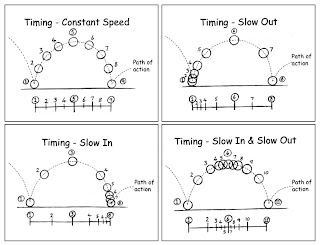There are 12 basic principles of animation introduced by the Disney animators Ollie Johnston and Frank Thomas in their 1981 book The Illusion of Life: Disney Animation.
- SQUASH AND STRETCH
This principles Squash and Stretch is contracting and expanding movement within a shape as it moves through action. Also squash and stretch is useful in animating dialogue and doing facial expressions.
- SLOW-OUT AND SLOW-IN
- EXAGGERATION
- FOLLOW THROUGH AND OVERLAPPING ACTION
- ANTICIPATION
- the preparation for the action - this is anticipation
- the action
- the termination of the action
- STAGING
- STRAIGHT AHEAD ACTION AND POSE TO POSE
- ARCS
- SECONDARY ACTION
- TIMING
- SOLID DRAWING
- APPEAL
Appealing animation does not mean just being cute and cuddly. All characters have to have appeal whether they are heroic, villainous, comic or cute. Appeal, as you will use it, includes an easy to read design, clear drawing, and personality development that will capture and involve the audience's interest.
.gif) |
| "My mum told me never to forget my principles" |


No comments:
Post a Comment